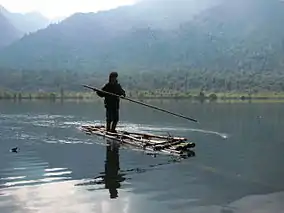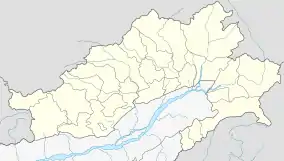Kamlang Wildlife Sanctuary
The Kamlang Wildlife Sanctuary, established in 1989, is rich in flora and fauna. It is situated in the Lohit District of the northeastern Indian state of Arunachal Pradesh. The park is named after the Kamlang River which flows through it. The Mishmi, Digaru Mishmi, and Miju Mishmi people tribal people who reside around the periphery of the sanctuary claim their descent from the King Rukmo of the epic Mahabharata. They believe in a myth of an invisible god known as Suto Phenkhenynon jamalu. An important body of water in the sanctuary is the Glow Lake. Located in tropical and sub-tropical climatic zones, the sanctuary is the habitat of the four big cat species of India: tiger, leopard, clouded leopard and snow leopard.[2][3]
| Kamlang Wildlife Sanctuary/Tiger Reserve | |
|---|---|
 Glow Lake in Kamlang Wildlife Sanctuary | |
  | |
| Location | Lohit District, Arunachal Pradesh, India |
| Nearest town | Wakro |
| Coordinates | 27°40′00″N 96°26′00″E |
| Area | 783 square kilometres (302 sq mi) |
| Established | 1974 |
| Governing body | Government of India, Government of Arunachal Pradesh |
| [1] | |
Topography
The sanctuary is in the South-Eastern part of Lohit District. Established in 1989, it covers an area of 783 square kilometres (302 sq mi).[1] The Lang River forms its northern border and the Namdapha National Park is on its southern border. Wakro town in the Namsai Sub-Division is close to the sanctuary. Namsai town is 70 kilometres (43 mi) away from Wakro. The nearest rail head and airport are Tinsukia and Dibrugarh respectively.[2] It is one of the twelve protected areas in the state of Arunachal Pradesh.[3]
The park has a number of bodies of water above an elevation of 600 metres (2,000 ft). These include the Glow Lake, at an elevation of 5,000 feet (1,500 m), covering an area of 8 square kilometres (3.1 sq mi)[4] and with a circumference of about 4–5 kilometres (2.5–3.1 mi); it is accessible only by trekking. Another notable topographic feature within the park is the "Parshuram Kund" ('kund' means "pond") which is a pilgrimage place.[2]
Flora
The upper reaches of the park have Alpine vegetation, particularly on the Daphabhum peak which borders the Namdapha National Park. The lower reaches (below 1,200 metres (3,900 ft)), including the foothills, have tropical wet evergreen forests. 150 tree species have been reported in the park. The main trees found in the park are Canarium resiniferum, Terminalia chebula, Gmelina arborea and Amoora wallichii. A great variety of herbs, bamboos, grasses, and shrubs are also present,[2][3] and 49 species of orchids have also been reported from the park. [5]
Wildlife
Wildlife in the park is similar to that found in the contiguous area of the Namdapha Tiger Reserve; there are 61 species of mammals, 105 bird species and 20 species of reptiles. Apart from the four big cats: tiger, leopard, clouded leopard and snow leopard, other notable animal species reported in the park are elephant, leopard cat, wild boar, civet, deer, giant squirrel and flying squirrel.[2] Of the fifteen species of primate found in India, six species are found in the park. These are capped langur (Trachypithecus pileatus), rhesus macaque (Macaca mulatta), stump-tailed macaque (Macaca arctoides), Assam macaque (Macaca assamensis), hoolock gibbon (Bunopithecus hoolock), and Bengal slow loris (Nycticebus bengalensis).[3]
References
- "Wildlife:Kamlang". Government of Arunachal Pradesh. Archived from the original on 12 May 2015. Retrieved 19 May 2015.
- "Kamlang Wildlife Sanctuary". Aruanchal Forest Department. Archived from the original on 22 February 2015. Retrieved 19 May 2015.
- "Demwe Lower HE Project (1750 MW):Protected Area" (pdf). Arunachal State Pradesh Power Corporation Board.
- "Jewels of Namsai district". Arunachal Times. 29 November 2014. Archived from the original on 23 September 2015. Retrieved 20 May 2015.
- "Contributions To The Orchid Flora Of Kamlang Wild Lifesanctuary In Lohit District Of Arunachal Pradesh". Bulletin of Arunachal Forest Research 22 (1&2). 2006.